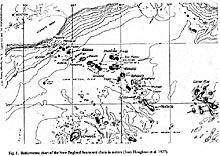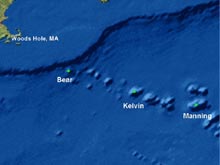Mission Plan: Mountains in the Sea
Ivar Babb, Director
National Undersea Research Center, UCONN
The New England Seamounts
The New England seamounts make up the longest seamount chain in the North Atlantic. They encompass more than 30 major volcanic peaks extending from Georges Bank southeast for about 1,100 km to the eastern end of the Bermuda Rise, ending abruptly with Nashville Seamount to the East Northeast of Bermuda.
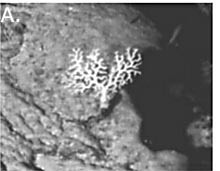
Representative octocorals from dives conducted in 1974: A. Dive 539, Gills Seamount' (photo courtesy of J. Adkins). Click image for larger view.
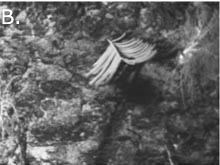
Representative octocorals from dives conducted in 1974: B. Dive 541, Manning Seamount; (photo courtesy of J. Adkins). Click image for larger view.
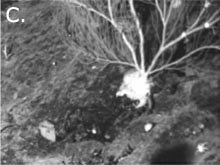
Representative octocorals from dives conducted in 1974: C. Dive 538, and Nashville Seamount; (photo courtesy of J. Adkins). Click image for larger view.
The major peaks of the New England seamounts rise as much as 4,000 m above the Sohm Abyssal Plain. About 300 km east of Nashville Seamount, the Corner Rise seamounts form a cluster of peaks midway between the eastern end of the New England seamounts and the Mid Atlantic Ridge. The New England seamounts and Corner Rise seamounts resulted from a mantle-plume hotspot, which moved from southern Quebec towards the Mid-Atlantic Ridge.
Four New England seamounts exist within 200 nautical miles of the U.S. Exclusive Economic Zone (EEZ). Their minimum depths are: Bear (1,102 m), Physalia (1,848 m), Mytilus (2,269 m), and Retriever (1,819 m). Several other New England seamounts outside the US EEZ are significant biologically because they rise to relatively shallow depths. They include Balanus (1,469 m), Kelvin (1,599 m), Atlantis II (1,645 m), Gosnold (1,409 m), Gregg (893 m), San Pablo (1,093 m), Manning (1,312 m) and Rehoboth (1,217 m). Nashville seamount is much deeper (1,975 m), but it is significant biogeographically because it is the easternmost seamount.
The geology of the New England seamounts and the effects of the seamounts on the flow regime of the Gulf Stream have been studied extensively, but the biota has been almost completely ignored. In fact, a review of literature about the biogeography of seamount faunas around the world notes only one species from the entire New England seamount chain (the stony coral Enallopsammia rostrata from Gregg Seamount).
Jon Moore, one of our expedition team members, has examined archived photos taken during the geological investigation of the New England seamounts. He has shown that more than 50 species of invertebrates and at least eight species of fishes were photographed on these seamounts.
In 1997, exploratory commercial fishing on Bear Seamount (the closest New England seamount within the US EEZ) captured seven more fish species, including three exotic species—two previously seen only in the eastern Atlantic and one found only in the temperate Southern Hemisphere).
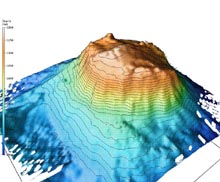
A multibeam swath bathymetric image of Bear Seamount produced on the OE sponsored Deep East mission in 2001. Click image for larger view.
To learn more about New England seamounts fauna, NOAA's National Marine Fisheries Service conducted an initial research survey of Bear Seamount in December 2000. During a single cruise on and over Bear Seamount, at least 115 species of fish and 185 species of invertebrates were caught and identified. A second cruise in July 2002 added to that species list. The total number of species identified is now 214 invertebrates and 203 fishes. This indicates that the fauna of Bear Seamount is highly diverse and suggests that the other New England seamounts also harbor a high diversity of macro-organisms.
Objectives
To better understand the coral and other species biodiversity patterns on the seamounts, we plan to do the following on this expedition:
1. map the distribution of the octocorals and assess the overall diversity of organisms living in the coral communities of the New England seamount chain;
2. determine the reproductive state and potential larval strategies of seamount octocorals;
3. investigate the colonization dynamics of dense coral aggregations;
4. determine whether seamount octocorals are genetically isolated between seamounts and from continental slope species;
5. determine the relationship of demersal nekton to the landscape features with and without corals; and
6. assess the physical impact of bottom trawling on octocoral communities and seamount biodiversity.
Significance
This expedition is truly exploratory in nature. In fact, one of the seamounts (Kelvin) has never been visited. Manning was visited once in 1974 and just recently by our collaborator, Jess Adkins, and only two dives in 1968 were ever conducted on Bear. We are almost certain to find a number of species on the seamounts that are new to science, especially from the middle and eastern portions of the chain. In addition, the species distribution information will significantly add to our understanding of community and biogeographic patterns in benthic deepwater organisms. This information will directly support the Census of Marine Life initiative.
Deepwater reef-like habitats are extremely unique and sensitive environments. The deep-sea coral habitats we are likely to encounter are poorly understood, but they are sensitive to bottom fishing activities and are potentially significant indicators of climate change. We anticipate that the New England seamounts will prove to be as biologically rich as seamounts in other regions of the world’s oceans. Ultimately, we hope the results of this expedition will help establish protection of seamount fauna in the North Atlantic.




















